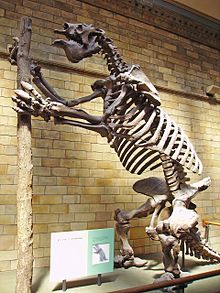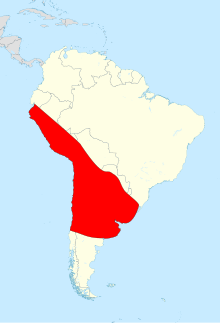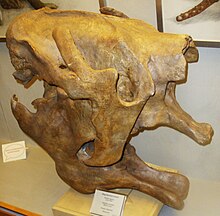大地懒
| 大地懒属 | |
|---|---|

| |
| 美洲大地懒(M. americanum)石膏骨架,保存于伦敦自然史博物馆 | |
绝灭(公元前8,500年)
| |
| 科学分类 | |
| 界: | 动物界 Animalia |
| 门: | 脊索动物门 Chordata |
| 纲: | 哺乳纲 Mammalia |
| 目: | 披毛目 Pilosa |
| 科: | †大地懒科 Megatheriidae |
| 亚科: | †大地懒亚科 Megatheriinae |
| 族: | †大地懒族 Megatheriini |
| 亚族: | †大地懒亚族 Megatheriina |
| 属: | †大地懒属 Megatherium Cuvier, 1796 |
| 模式种 | |
| †美洲大地懒 Megatherium americanum Cuvier, G., 1796
| |
| 种 | |
| |

| |
| 异名 | |
| |
大地懒属(学名:Megatherium)是一种巨大的动物,属于异关节总目披毛目树懒亚目下的大地懒属的物种。见于上新世早期至更新世[2]晚期的中美洲和南美洲。在所有其他陆生哺乳动物当中,只有少数生物体形可以超越大地懒,包括猛犸象以及更古老的巨犀。
分类学
[编辑]
大地懒的化石最早由 Manuel Torres 于 1788 年在阿根廷卢汉河的河岸边发现,该化石在隔年后运送至马德里的国家自然科学博物馆展示至今。该化石由博物馆员工 Juan Bautista Bru 负责重新组装,另外也包括整幅骨架与部分骨头的个别描绘[3]。
透过 Bru 的描绘与比较解剖学,乔治·居维叶得以整理出大地懒的外貌及与现今种类的亲缘关系。他于 1796 年将于法国科学院演说的演讲抄本改写后发表了他的第一篇论文,并于 1804 年针对同主题再发表了一篇论文,论文在之后收录于居维叶的《Recherches sur les ossemens fossiles de quadrupèdes(翻译:针对四足动物骨骼化石之研究)》中[4]。在居维叶 1796 年的论文中,他将化石命名为美洲大地懒(Megatherium americanum),并且透过比较解剖学认为大地懒与现存的树懒为近亲,他起初认为大地懒的爪子跟现存的树懒一样可以用来爬树,但在之后提出假说认为它们生活于地底,并用爪挖掘隧道[4]。
大地懒与其他西方巨型生物群化石的发现在乔治王时代引发风潮直到数十年后恐龙化石的发现才被盖过。
在这之后,大地懒的化石在整个南美洲都有发现,包括阿根廷、玻利维亚、巴西、智利、哥伦比亚(基皮莱、昆迪纳马卡省)[5][6]、圭亚那、巴拉圭、秘鲁及乌拉圭[2]。大地懒属中的新种 M. urbinai 及 M. celendinense 分别于 2004 及 2006 年发表[7]。M. celedinense的命名来自于秘鲁卡哈马卡省的塞伦丁[8]。
描述
[编辑]

大地懒是已知体型最大的几种陆生哺乳动物之一,体重可达4吨[9],全长从头至尾端则可达6米[10][11],属于目前已知最大型的地懒,体型甚至可比拟现代的大象。大地懒属于更新世巨型动物群中的一员,为当时更新世最大型的数种哺乳动物之一。
大地懒拥有厚重的骨架结构、宽厚的骨盆与强壮的尾巴,搭配其巨大的体型让大地懒可以使用后脚和尾巴如三脚架般稳定直立,如此一来便可以获取其他同时期食草动物所不能构到的食物。大地懒可以运用前肢上的弯爪勾取树枝并取食其上之树叶。和食蚁兽一样,大地懒的足上也有爪,这使得大地懒的脚掌无法平整的贴于地面而必须以足外缘着地来行走。大地懒为四足动物,但是从它的行迹化石上与生物力学[12]的角度观察来看,大地懒也具有不差的双足行走能力。
有些科学家相信大地懒拥有一条长舌头(类似于长颈鹿和树懒),这样一来就可以透过舌头将树叶卷入口中,但这个理论并没有得到全面性的认同。
生活习性
[编辑]大地懒主要在南美洲[13]疏林地区上的林地和草原生活,为当地之特有种并且持续存活直到约10,000年前。大地懒可以适应温带、干旱性与半干旱性气侯的环境,其近亲泛美地懒(Eremotherium)[14]居住在更加北部的热带地区,甚至在南北美洲生物大迁徙时,成功入侵到温带的北美洲。
古生物学
[编辑]
大地懒通常为群体生活,但也有部分个体会单独生活在洞穴中。大地懒并没有什么天敌,因此可能为昼行性生物。
大地懒为草食动物,以啃食丝兰、龙舌兰的叶子或者是吃草为主,但也会透过后脚直立来取得高树上的嫩枝与树叶。大地懒透过强壮的颊肌与构造简单的牙齿来咀嚼,并透过胃来消化这些包含粗劣纤维的食物,也因此大地懒可能会耗费大量时间休息来协助消化。
近年来的研究[9]指出美洲大地懒(M. americanum)具有强大的垂直咬合力,从牙齿的形状指出大地懒可能更适合切断而不是去研磨食物,也因此高纤食物可能不是主要的食物来源。
有些仍有争论性的理论指出大地懒可能为部分肉食性,研究指出其肘突(手肘上三头肌附着点)很短,适合强化挥动速度而不是力量,这个特征通常只会在肉食动物上发现,这让大地懒可以让其利爪像匕首那样挥舞。大地懒可以透过食肉来摄取一些额外的营养,可能透过夺取斯剑虎的战利品。透过分析其二头肌的机械功率与预估强度,大地懒甚至有能力可以翻过成年的雕齿兽,也因此可以将其当作猎物猎杀[15]。但是大地懒缺乏一般掠食者所拥有的裂肉齿且在大地懒粪便中也没有发现到骨头碎片,这个理论仍然缺乏重要的证据。
灭绝
[编辑]在更新世中,大地懒和其他原始哺乳动物受到影响,造成绝种的危机,原始哺乳动物灭绝,同时大地懒灭绝。在南美洲,大地懒存活至约 10,500 年前,一般认为是由于人类领域的扩张与狩猎才导致其绝种的[16]。也有些指出可能有部分个体至 8,000 至 7,000年前仍然存活着[17],但普遍依然认为是在 10,000 年绝种的[18]。透过分析显示适合大地懒生存的栖息地在全新世中期时大幅缩减并变得破碎,这也许不是其灭绝的主要原因,但仍然为可能的要素之一[19]。
参见
[编辑]参考资料
[编辑]- ^ Saint-André, P. A.; De Iuliis, G. The smallest and most ancient representative of the genus Megatherium Cuvier, 1796 (Xenarthra, Tardigrada, Megatheriidae), from the Pliocene of the Bolivian Altiplano (PDF). Geodiversitas. 2001, 23 (4): 625–645 [14 April 2016]. (原始内容 (PDF)存档于2013-10-29).
- ^ 2.0 2.1 A. E. Zurita, A. A. Carlini, G. J. Scillato-Yané and E. P. Tonni. 2004. Mamíferos extintos del Cuaternario de la Provincia del Chaco (Argentina) y su relación con aquéllos del este de la región pampeana y de Chile. Revista geológica de Chile 31(1):65-87
- ^ Piñero, J. M. L. Juan Bautista Bru (1740–1799) and the description of the genus Megatherium. Journal of the History of Biology. Spring 1988, 21 (1): 147–163. doi:10.1007/BF00125797.
- ^ 4.0 4.1 Argot, Christine. Changing Views in Paleontology: The Story of a Giant (Megatherium, Xenarthra). Sargis, E. J.; Dagosto, M. (编). Mammalian Evolutionary Morphology: A Tribute to Frederick S. Szalay. Springer. 21 May 2008: 37–50 [2019-12-04]. ISBN 978-1-4020-6997-0. OCLC 236490247. (原始内容存档于2014-07-20).
- ^ Bürgl, Hans. Restos de Megatherium y otros fósiles de Quipile, Cundinamarca. INGEOMINAS: 1–14. 1956 [2017-05-03]. (原始内容存档于2020-10-09).
- ^ De Porta, Jaime. La posición estratigráfica de la fauna de Mamíferos del pleistoceno de la Sabana de Bogotá. Boletín de Geología, Universidad Industrial de Santander. 1961, 7: 37–54 [2017-05-03].
- ^ Pujos, François; Salas, Rodolfo. A new species of Megatherium (Mammalia: Xenarthra: Megatheriidae) from the Pleistocene of Sacaco and Tres Ventanas, Peru. Palaeontology. 2004, 47 (3): 579–604. doi:10.1111/j.0031-0239.2004.00376.x.
- ^ Pujos, François. Megatherium celendinense sp. nov. from the Pleistocene of the Peruvian Andes and the phylogenetic relationships of Megatheriines. Palaeontology. 2006, 49 (2): 285–306. doi:10.1111/j.1475-4983.2006.00522.x.
- ^ 9.0 9.1 Bargo, M. S. The ground sloth Megatherium americanum: Skull shape, bite forces, and diet (PDF). Acta Palaeontologica Polonica. 2001, 46 (2): 173–192 [22 July 2012]. (原始内容存档 (PDF)于2011-05-22).
- ^ Megatherium Wildfacts. BBC. [22 July 2012]. (原始内容存档于2012-05-24).
- ^ Haines, T.; Chambers, P. The Complete Guide to Prehistoric Life. Italy: Firefly Books Ltd. 2007: 192–193. ISBN 1-55407-181-X.
- ^ Casinos, A. Bipedalism and quadrupedalism in Megatherium: An attempt at biomechanical reconstruction. Lethaia. 1996, 29: 87–96. doi:10.1111/j.1502-3931.1996.tb01842.x.
- ^ McKenna, M. C.; Bell S. K. Classification of Mammals Above the Species Level'. New York: Columbia University Press. 1997: 631 [22 July 2012]. ISBN 023111012X.
- ^ Cisneros, J. C. New Pleistocene vertebrate fauna from El Salvador (PDF). Revista Brasileira de Paleontologia. 2005, 8 (3): 239–255 [2014-05-27]. doi:10.4072/rbp.2005.3.09.
- ^ Fariña, R. A.; R. E. Blanco. Megatherium, the stabber. Proceedings of the Royal Society of London. 1996, 263 (1377): 1725–1729. PMID 9025315. doi:10.1098/rspb.1996.0252.
- ^ Steadman, D. W.; Martin, P. S.; MacPhee, R. D. E.; Jull, A. J. T.; McDonald, H. G.; Woods, C. A.; Iturralde-Vinent, M.; Hodgins, G. W. L. Asynchronous extinction of late Quaternary sloths on continents and islands. Proc. Natl. Acad. Sci. USA (National Academy of Sciences). 2005-08-16, 102 (33): 11763–11768 [2009-01-24]. PMC 1187974
 . PMID 16085711. doi:10.1073/pnas.0502777102. (原始内容存档于2021-02-24).
. PMID 16085711. doi:10.1073/pnas.0502777102. (原始内容存档于2021-02-24).
- ^ Turvey, Sam. Holocene extinctions. Oxford University Press. 2009: 24 [2017-11-26]. ISBN 0-19-953509-4. (原始内容存档于2020-08-17).
- ^ Fiedal, Stuart. Sudden Deaths: The Chronology of Terminal Pleistocene Megafaunal Extinction. Haynes, Gary (编). American Megafaunal Extinctions at the End of the Pleistocene. Springer. 2009: 21–37 [2017-11-26]. ISBN 978-1-4020-8792-9. doi:10.1007/978-1-4020-8793-6_2. (原始内容存档于2012-12-05).
- ^ Lima-Ribeiro, Matheus Souza; et al. Potential Suitable Areas of Giant Ground Sloths Dropped Before its Extinction in South America: the Evidences from Bioclimatic Envelope Modeling.. Natureza & Conservação. December 2012, 10: 145–151. doi:10.4322/natcon.2012.022.





